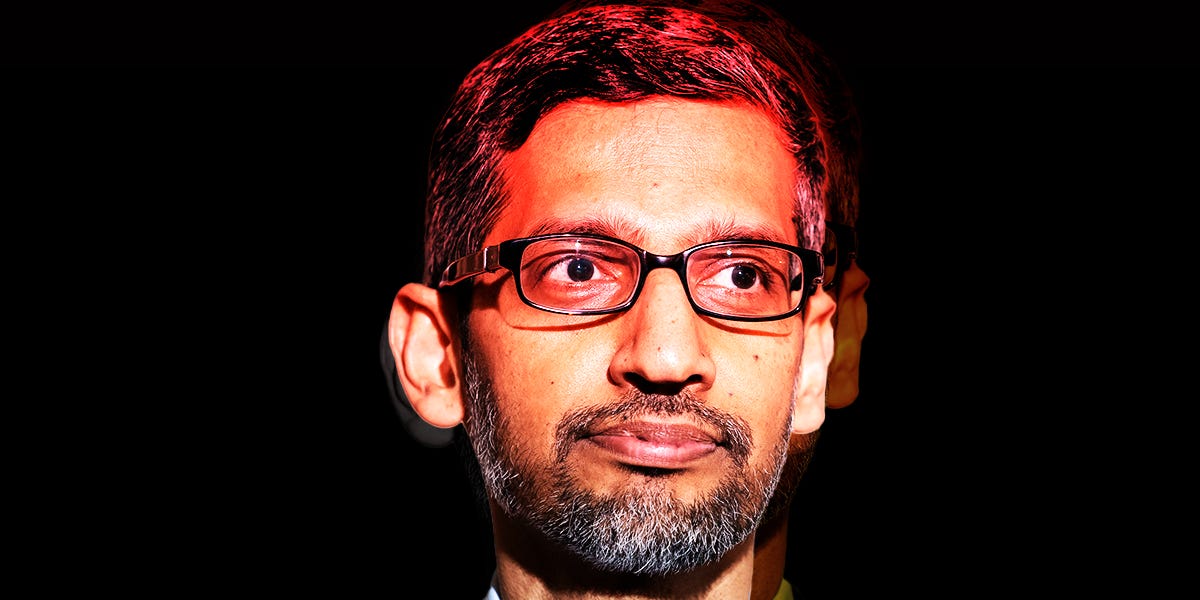In April, Google indulged in one of its favorite pastimes: a reorg.
Executive musical chairs has become all too common inside Alphabet. Still, this shake-up was one of the most dramatic in the company’s 25-year history. CEO Sundar Pichai announced he would smash together two of the company’s major units — platforms and devices — into a supergroup that would focus on Android, Chrome, and the gadgets Google builds, such as the Pixel phone. In a memo to staff, Pichai said the move would “turbocharge the Android and Chrome ecosystems” and speed up decision-making.
The announcement rounded out a dramatic year of change inside the search giant. It came almost 12 months after Google combined two key artificial-intelligence groups, DeepMind and Google Brain. The timing is no coincidence: Google has been battling a narrative that it’s fallen behind in AI, slipped into complacency, and become an industry laggard. There have even been calls for Pichai to step down.
In response, Pichai redesigned his leadership team to move faster and foster more collaboration between historically siloed parts of the business. To do so, he has looked inside the company and moved up a mixture of longtimers and established leaders to run the next era of Google.
Pichai now has 18 direct reports, according to an internal org chart seen by Business Insider, though this includes names such as former YouTube CEO Susan Wojcicki who now act as company advisors. Pichai’s updated leadership team still outsizes many of Google’s peers, though several leaders now have oversight over more teams as the company streamlines and removes walls.
A Google spokesperson did not respond to a request for comment for this story.
Google’s AI MVP
Demis Hassabis might be the most important person at Google right now.
The DeepMind founder and CEO, who sold the startup to Google in 2014, spent most of the past decade running the unit at an arm’s length from the mothership. Then, in April last year, Pichai announced he would merge DeepMind with Google’s in-house AI unit, known as Brain, into a supergroup named Google DeepMind.
Hassabis is in charge of this new AI command center — he referred to the unit as the “engine room of Google in the AI era“ — and oversees about 2,600 employees, according to internal data seen by BI. This week, in another sign of how Google has bear-hugged its AI crown jewel, Hassabis made his debut onstage at Google I/O.
Hassabis has accrued more power in recent months. As part of last month’s reorganization, Pichai said some other teams within the research group — including those building machine-learning models — would become part of Google DeepMind. Hassabis’ unit would also absorb the Responsible AI group, in charge of safely developing AI.
Consolidating teams may help Hassabis and Google DeepMind move faster toward their goal of building artificial general intelligence — a mandate agreed upon by Hassabis and Google’s cofounder Larry Page when DeepMind was acquired. It also means Hassabis now works closer with the employees who inject AI into Google’s major products. The merger last year meant DeepMind sacrificed some projects deemed too academic or that didn’t have a clear path to consumer-facing products, a former employee said.
The former and current Google employees BI spoke with for this story spoke on condition of anonymity because they were not permitted to speak to the press. Their identities are known to us.
Some insiders have floated Hassabis as a candidate for Google’s CEO chair, though two people close to the DeepMind cofounder suggested that the day-to-day management of a nearly 200,000-employee company would be Hassabis’ idea of hell.
That’s not to say he doesn’t have to do his fair share of corporate diplomacy right now. The merger of Google’s AI units meant Brain and DeepMind must move past a yearslong rivalry that had caused friction over how much research should be shared between the teams (and went as far as keeping their code from one another), former employees said.
Under Hassabis’ stewardship, Google has gained ground on OpenAI with the release of its large language model Gemini. It also faced setbacks, including an embarrassing debacle in which Gemini’s image generator created historically inaccurate images of people of color.
With OpenAI still moving fast on productizing its research, Google can’t afford to slow down. One employee said it’s busy training Gemini’s successor model, and at this week’s I/O conference, the company unveiled countless new whiz-bang products running on Gemini.
Pixel’s leader accrues more power
Colliding Google’s services and hardware groups wasn’t just a dramatic structural shake-up; it showed a huge vote of confidence in Rick Osterloh, the hardware chief who’s built out that division for the past eight years.
It was also a signal that Google wanted to get more serious about its hardware such as Pixel, particularly as it looked to seize a crucial opportunity with AI on Android. In a note to staff in April, Pichai said the change would give Google an “incredible opportunity to reimagine computing platforms for the next decade.”
Google also promoted Sameer Samat to the president of the Android ecosystem in April. Previously a vice president and general manager, he’ll effectively replace Google’s former Android leader, Hiroshi Lockheimer, who stepped aside last month to take on other projects inside Google.
Osterloh now oversees almost 25,000 employees, giving him one of the biggest units at the company, per internal documents — about the same size as Google’s Search and ads group, which is run by Prabhakar Raghavan, a senior vice president.
Some current and former employees have expressed disappointment with the headway Google has made in hardware under Osterloh’s leadership (including fumbling products such as Fitbit and Stadia). Google’s Pixel smartphones have improved features and design, yet they have barely made a dent in the market.
While Apple is working to bring AI features to the iPhone, The New York Times reported, Siri has so far disappointed as an AI assistant, giving Google an opportunity to combine its AI and hardware into something much more compelling.
Under Osterloh’s watch, Google has struggled to catch up to Apple in another category: augmented reality. Leadership shuffles and strategy pivots have beset the unit’s attempts to build something that could rival Apple’s Vision Pro.
Google has made progress with the technology it acquired from Raxium in 2022, an employee with knowledge of the matter said, which would pave the way for Google’s own AR device. In the short term, Google still plans to launch its Android XR operating system and find partners to build glasses on top of it, as BI previously reported and Pichai hinted at Tuesday during an interview with CNBC.
Osterloh will spend the next few weeks and months playing diplomat and assuring Android partners nothing will change in that department. For many years, a firewall has existed between Google’s hardware and Android units — a way for Google to avoid playing favorites with its own devices.
Some employees within Android’s organization saw Osterloh as responsible for recent layoffs in the hardware division, which has concerned them that their jobs may suddenly be more vulnerable, one current employee said.
Others inside Google say Osterloh is a good bet, with the necessary sharp elbows — and now the resources — to make the moves that could start keeping Apple CEO Tim Cook awake at night.
One executive said Osterloh was willing to make the decisions that “would piss a lot of people off” if needed.
“Hiroshi is nicer, but nice doesn’t get you anywhere at Google,” they added, “at least not anymore.”
A Search veteran takes the reins
In March, Google appointed a company veteran, Liz Reid, as the head of Search as part of a larger change of guard inside the company’s most valuable product.
While Reid’s appointment received less attention than other recent moves, her promotion was significant. Reid reports directly to Raghavan, the ads and search senior vice president, and is shepherding a dramatic transition of Google Search. At this week’s I/O event, Google announced that AI Overviews — the company’s generative-AI search experience — was being rolled out in the US and would be available to more than 1 billion people by the end of the year.
Reid, who joined the company in 2003 as one of the first Google Local engineers, has spent her career there focusing on how to surface high-quality and relevant information to users. In 2021, BI reported that Reid took on a bigger role on Google Search and has since turned her attention to working on AI features.
In another signal of AI’s importance to Google Search’s future, the company has also elevated Cheenu Venkatachary, a product vice president who joined Google to work on AI, to lead Search quality and ranking. Pandu Nayak, whom Venkatachary replaced, stepped aside to take a chief-scientist role and will continue to consult on issues such as search quality and ranking.
With Google’s generative-AI search now rolling out, Reid and the team face big challenges: increasing AI-generated spam, a decline in visibility for publishers, and turbulence for the company’s cash cow, search advertising.
It’s also battling chatbots from companies such as Perplexity and OpenAI that increasingly behave like search engines, with reports that OpenAI could be close to launching an all-out search product of its own. Fears of chatbots eating into Google’s search dominance have yet to be realized, giving Google time to reinvent its most hallowed product. Still, it knows it has to move fast.
“While smaller companies like Perplexity gain a lot of solid PR, it hasn’t really shown up in the numbers for query share,” the Bernstein senior analyst Mark Shmulik told BI. “I think Google’s actually executing well with regards to something that was viewed as an existential risk a year ago.”
Read the full article here





